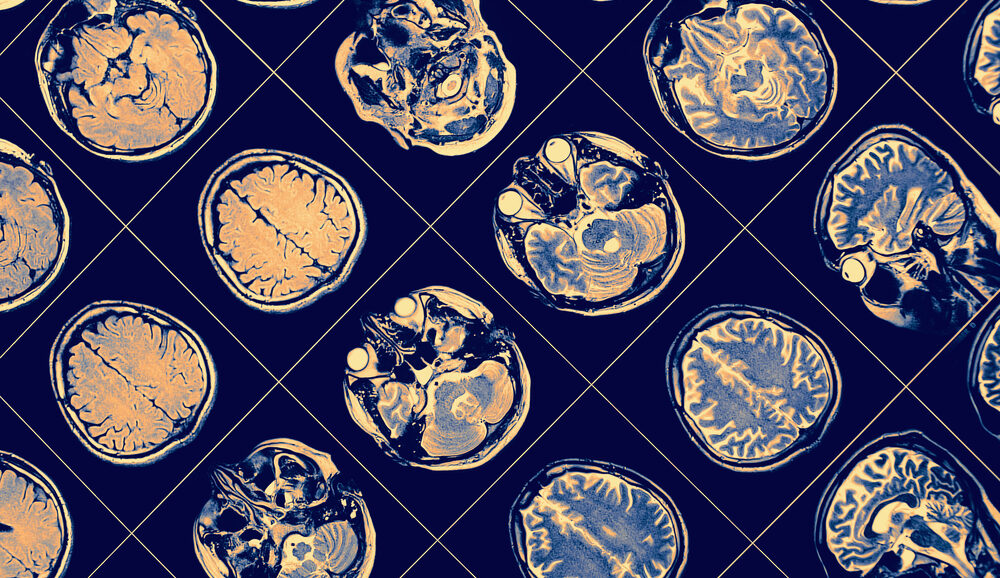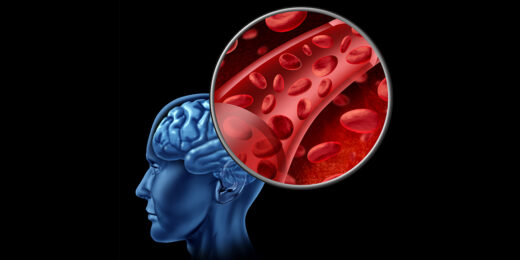On Jan. 31, aducanumab, a pricey drug approved for treatment of early-stage Alzheimer's disease, was withdrawn from the market. And in early March, the Food and Drug Administration delayed its decision regarding whether to approve a separate, closely similar drug. A prescient commentary by Stanford Medicine neurologist Mike Greicius, MD, in a peer-reviewed journal goes a long way toward explaining why.
Decades of research have produced scant advances in countering Alzheimer's, with a patient population exceeding 6 million in the United States. Early drugs developed to counter it treated some symptoms rather than any inherent causes of the disease, and they worked about as well as walking backward on a moving train. They may compensate slightly and briefly for the condition's memory-robbing aspects, but they don't slow down the underlying runaway destruction of nerve circuitry in the brain.
Aducanumab is a newer drug intended to ameliorate symptoms by homing in on a likely cause of Alzheimer's disease. It was designed to pull from Alzheimer's patients' brains a sticky substance called A-beta that clumps up into gummy deposits called amyloid plaque.
Alzheimer's cognitive effects, it's long been known, are heralded by the buildup of amyloid plaque in the brain. Hopes have been high for new drugs based on the idea that amyloid plaque is the smoking-gun cause -- or at least one cause -- of the slow, but steady, crumbling of memory that's one of Alzheimer's behavioral hallmarks.
Alas, the clinical benefits of aducanumab and a couple of similar "plaque-attack" drugs have proved less than stellar. Where did this approach go off-track?

The attack on plaque suffers a setback
Aducanumab received accelerated approval in 2021 from the Food and Drug Administration after a pair of late-stage trials showed skimpy enough results that neither Medicare nor private insurance companies would cover the drug at a price tag of $56,000 a year.
While its withdrawal comes as a disappointment for patients and advocacy groups, it probably made good financial sense to its owner, Biogen. Aducanumab has netted a mere $3 million in sales to date, implying that fewer than 100 people have reached into their pockets to pay the full price since its approval.
Whatever. A similarly acting drug, lecanemab, marketed by Biogen in partnership with Eisai, was approved in 2023. Only about 2,000 individuals are receiving lecanemab, which costs $26,000 a year.
The FDA has postponed its widely expected March 2024 approval of a third plaque-removing drug, donanemab, developed by Ely Lilly, pending further review by a committee of independent experts.
Some experts hold a low opinion of all three drugs. One of those is Greicius, who has spent decades examining Alzheimer's patients and conducting research on the pathology of disease progression.
Greicius, who is the Iqbal Farrukh and Asad Jamal Professor and the former director of the Stanford Center for Memory Disorders, thinks all three plaque-attack drugs are "decidedly underwhelming." Not because they fail to reduce plaque, Greicius said, but in spite of their success in doing so.
The three drugs attack plaque at somewhat different stages of its formation but are all meant to remove these deposits from the brain. And this they undoubtedly do.
"All are quite adept at pulling amyloid plaques out of the brain," Greicius said. "But none of these drugs makes much of a difference to the patient's wellbeing. The effect is tiny."
None of these drugs makes much of a difference to the patient's wellbeing. The effect is tiny.
Mike Greicius
Do the drugs even work?
In a commentary published Jan. 16 in the Journal of Alzheimer's Disease, Greicius, neurology intern Leonardino Digma, MD, and postdoctoral scholar Joseph Winer, PhD, aired several distinct criticisms of all the front-and-center amyloid-targeting drugs.
First, amyloid plaque may be a lousy tracker of Alzheimer's progression. Lots of people get lots of plaque but show no sign of anything more than normal age-related cognitive losses. The plaque deposits aggregate not within, but between, nerve cells. And the places where these deposits show up aren't necessarily the brain structures whose deterioration is most directly relevant to cognitive and memory loss, Greicius said.
Much more closely tied to nerve-cell breakdown and associated cognitive loss are another kind of deposit known as neurofibrillary tangles: stringy aggregates composed largely of a protein called tau. Neurofibrillary tangles are situated within, rather than between, nerve cells, and their presence strongly correlates with nerve-cell and nerve-circuit damage to brain structures implicated in memory and the ability to think.
So, then, why didn't drug developers initially focus their efforts on neurofibrillary tangles instead of amyloid plaque?
While most Alzheimer's cases occur late in life, a small fraction of cases begin much earlier and are clearly heritable. Examination of these familial early-onset cases have pinpointed mutations in the protein whose A-beta snippets aggregate to form amyloid plaque. That drug developers might contemplate a method of removing amyloid plaque from the brain was reasonable. There was no similar early genetic tie-in with tau-rich neurofibrillary tangles, which manifest later in the course of Alzheimer's pathology than amyloid deposits do.
But there's little to no evidence that removing amyloid plaque from the brain actually improves cognitive function.
We're seeing patients in the trials getting plaque pulled out but without any real impact on their memory, mood or cognition.
Mike Greicius
"Just because A-beta plays some kind of role early on -- and it clearly does -- doesn't mean removing plaque is going to be helpful," said Greicius, who is also a steering committee member of the Knight Initiative for Brain Resilience at Stanford's Wu Tsai Neurosciences Institute. "We're seeing patients in the trials getting plaque pulled out but without any real impact on their memory, mood or cognition."
The plaque-attack drugs' clinical trials did achieve what researchers call "statistical significance," meaning the observed effects were unlikely to have been illusory. But the size of the effect matters, too. If you add a drop of water to an almost full glass of water, you can be absolutely confident that the water level in that glass will rise. But, so what.
"Even assuming the plaque-attack drugs' observed effects on cognition were real, it was so small a clinician wouldn't notice it," Greicius said. This holds true even for donanemab, as evidenced by a late-stage trial that recorded the largest cognitive improvements.
The incredible shrinking improvement
The three drugs' clinical effects probably weren't even as big as claimed.
In a well-structured late-stage, or phase 3, drug trial, participants are randomly assigned to either the placebo or active-treatment arm. Only half of them get the real drug. The rest get a placebo: an inert stand-in that appears to be the drug. Nobody -- not the patient, not the patient's caretaker, not the treatment- or test-administering clinicians, not even the scorekeepers recording test results -- knows if a particular patient is getting the real drug or its stand-in, until the analysis is complete.
"The placebo effect is a very real thing," Greicius said. People who think they're receiving the real drug typically have substantially more enthusiastic positive expectations -- and do better -- than those who don't know if they're getting a placebo or, for some reason, suspect that they are.
In all three drugs' late-stage clinical trials, a large fraction of participants in the treatment arm (or their caretakers or administering or test-giving clinicians) may have figured out before the trial was finished that they were getting the real deal.
The plaque-removing drugs are not perfectly benign. Brain bleeding and swelling are common side effects of all three -- and ones rarely if ever seen among participants in the placebo arm.
We asked all three pharmaceutical companies sponsoring these trials if we could analyze their internal data, and we were politely but roundly denied
Mike Greicius
"We asked all three pharmaceutical companies sponsoring these trials if we could analyze their internal data, and we were politely but roundly denied," Greicius said. But publicly reported rates of this problem from all three drugs' clinical trials ranged from 20% to 37% of patients in the active-treatment arm. When brain imaging showed signs of bleeding or swelling in a participant, dosing was stopped pending resolution of the condition, which was monitored by repeated imaging at relatively short intervals.
Such an obvious procedural change could easily have tipped off patients, caretakers and clinicians that a patient was getting the real drug. And that conviction could have been enough to account fully or in large part for the modest clinical effect, Greicius said.
Plus, it's been learned during the course of the plaque-attack drugs' development that recipients are more susceptible to brain swelling or bleeding if they carry a genetic variant called APOE4, notorious for predisposing carriers to Alzheimer's disease. Statisticians could try to prevent the placebo effect in the active-treatment arm from overwhelming the actual drug effect by, say, effectively zeroing out the data on any trial participants experiencing brain bleeding or swelling.
But doing that would have systematically, if inadvertently, scrubbed participants with the worst prognosis from the treatment arm, while retaining the APOE4 carriers in the placebo group. (Remember, placebo recipients, even if they were APOE4 carriers, didn't develop brain bleeding or swelling.)
That tactic, alone, might have accounted for the puny observed beneficial effect of the drug on cognition, Greicius said.
"It would be an invaluable contribution on the part of drug developers to provide trial data to outside researchers," he said.
The FDA's decision to accept amyloid plaque reduction as likely to yield a clinical benefit was met with skepticism from the outset from the likes of Greicius.
"The results of anti-amyloid trials have justified this skepticism," wrote Greicius and his colleagues in their JAD paper.
Image: sfam_photo






